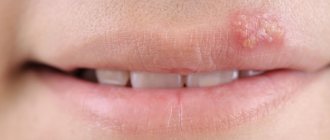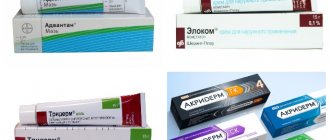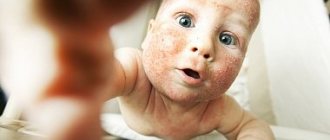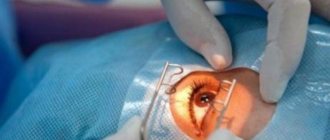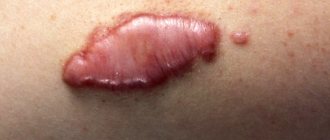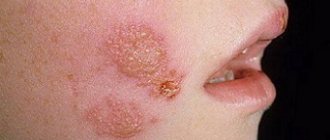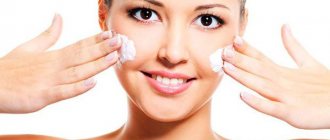What is impetigo and how to treat it?
Impetigo is a contagious skin disease caused by staphylococci or streptococci, sometimes a combination of both. The disease affects the upper layers of the epidermis and externally manifests itself in the form of multiple pustular rashes, turning into scabs with crusts. Most often, children attending child care institutions are susceptible to the disease. For adults, the likelihood of becoming infected is also possible, especially with a low level of personal hygiene.
Infection occurs through microtraumas - scratches, bites, cuts and abrasions. When pathogenic bacteria come into contact with a damaged layer of skin, they actively multiply, causing inflammation. Such microorganisms are always present on the surface of the skin, but with hygiene and regular washing, their number is significantly reduced and cannot cause skin diseases.
Causes
The main reasons, as a result of which impetigo begins to progress:
- non-compliance with sanitary and hygienic rules;
- weakened immune system;
- diabetes;
- formation of abrasions, bites, microcracks on the skin;
- hot climate (hot or humid);
- presence of foci of infection in a family member.
The main risk group includes people in the following categories:
- people who often visit public places - saunas, swimming pools, showers;
- children under 6 years old;
- who have suffered severe infectious or dermatological diseases.
It should be noted that the development of a pathological process is only possible if a person’s immune system is too weakened.
Causes of impetigo
Pathogenic bacteria are everywhere; you can completely get rid of pathogens only through special treatment (sterilization), and then only for a short time.
Even with daily hygiene procedures, transient flora and permanently resident bacteria are always present on the skin and do not cause infection. Under the slightest unfavorable conditions - prolonged wetness, untimely bathing, disruption of the sebaceous glands, scratches - bacteria instantly penetrate the dermis. The dermis immediately reacts to the invasion and inflammation develops. Various substances are released into the skin to destroy bacteria and restore integrity. The process ultimately ends with the cessation of inflammation and the formation of a scar, which gradually resolves.
Classification of impetigo
In dermatology, it is customary to classify impetigo (see photo) depending on the cause of the disease and clinical manifestations. There are:
1. Streptococcal (contagious) impetigo: the cause is streptococcus, which most often affects the skin of children and women. A very common and contagious form of impetigo.
Includes several varieties:
- Ring-shaped impetigo is a type of streptococcal type and is characterized by the appearance of large grouping conflicts. Their central part dries out, forming a crust, and new conflicts appear on the periphery, forming ring-shaped figures. This type of disease most often affects the feet, legs, back of the hands and the nail fold area.
- Lichen simplex (“dry” pyoderma) – occurs on the face of children and is considered an abortive form. It manifests itself clinically as erythematous pink spots with peeling. The elements resolve under sun exposure, leaving persistent depigmentation;
- Slit-like impetigo (jam) - develops in people who sleep with their mouths open, through the corners of which saliva passively flows, as well as in those who have the habit of licking their lips. It is clinically manifested by a rash of pustules in the corners of the mouth, at the wings of the nose, and outside the palpebral fissure. Pustules erode in the form of a slit-like defect in the skin and mucous membranes. The surrounding skin is tense, painful, and difficult to epithelialize, since lip movements break thin epithelial films;
- Bullous impetigo - manifests itself in the form of two-centimeter blisters with a dense tire, filled with cloudy exudate mixed with blood. The process is complicated by the appearance of swelling around the affected area, as well as an increase in temperature, headache, and weakness. A particularly severe course of the disease is observed in pre-existing skin diseases.
- Syphiloid impetigo is a disease noted in newborns. A distinctive feature is the rash of phlyctenas on the buttocks and in the subgluteal area. Phlyctenas open, forming erosions with an infiltrated base, resembling chancre, and are resolved by the formation of crusts that leave no trace behind;
- Vegetative impetigo - the disease is characterized by spontaneous spread of bursting blisters with the formation of erosions covered with purulent crusts;
- Impetigo of the mucous membranes - a rash of aphthae in the oral cavity, on the mucous membranes of the cheeks, gums, tongue, nasal passages, mucous membranes of the eyes;
- Intertriginous streptoderma - rashes are localized in large folds of the skin, where, due to aseptic conditions (sweat, weeping), continuous itchy and painful erosive surfaces with a halo of remaining epidermis along the periphery are formed. The boundaries of the lesion are clear, there is a tendency to peripheral growth.
2) Staphylococcal impetigo (ostiofolliculitis, Bockhart's impetigo) - occurs in men, children, and adolescents. Occurs at the mouths of hair follicles when the rules of basic cleanliness are not followed. If it persists for a long time without treatment, it transforms into a carbuncle. Available in two versions:
- Non-bullous form (superficial folliculitis) - caused by white staphylococcus, characterized by small (1.5 mm) purulent blisters, has no tendency to spread, the primary elements quickly dry out into crusts, which, falling off, leave no trace.
- Bullous form (deep folliculitis) - it is caused by Staphylococcus aureus. It manifests itself in the formation of a nodular-vesical rash (5 mm) around the hair follicles, the primary elements become denser, tend to penetrate into the deep layers of the skin, the vascular bed, therefore, in the clinic there are symptoms of intoxication, and the outcome of the process is a scar.
3. Mixed impetigo (vulgar impetigo) – occurs when streptococcal impetigo is complicated by staphylococcus, when the appearance of conflicts is accompanied by itching, scratching, and the addition of a secondary infection. The rashes are multiple, covered with thick crusts, localized in the face, neck, joints, near the nipples of the mammary gland, and on the genitals. Bullae and erosions are painful, tend to spread (through a dirty towel, bed linen), and regional lymph nodes are involved in the process.
Symptoms of impetigo
Inflammation caused by streptococcus manifests itself as small red blisters (up to 5 mm) with purulent contents. At first, the blisters are painful, but then the pain goes away, the blisters collapse and open, forming crusts. The whole process takes up to 2 months. Such vesicles can appear in any area of the body; the provoking factor is poor hygiene. The danger is the penetration of streptococcus into the blood and lymph, and from there into various organs with the development of myocarditis, nephritis, tonsillitis, rheumatism and even sepsis. Often, after streptococcal impetigo, panaritium develops - inflammation of the peri- and subungual bed. Staphylococcal impetigo is often localized around the hair follicles. Inflammation spreads deeper, causing the formation of ulcers, boils and even carbuncles. A lot of ulcers form at once; they cover almost all healthy skin. The lymph nodes react, become denser and hurt. Any type of impetigo is highly contagious.
Impetigo in children
Impetigo in children manifests itself in the formation of red spots that turn into scabs in the form of crusts. First of all, they become noticeable in the mouth, nose, behind the ears, and on the back of the hand. Conflicts sometimes occur on the gums, which causes the child a lot of inconvenience and pain. Children often experience rashes in the corners of the mouth, so-called jams.
Thin-skinned blisters burst, forming slit-like erosion. A crust quickly forms in its place. Long healing of wounds in children is the result of the habit of licking the corners of the mouth. Staphylococcus and streptococcus bacilli enter the child's body through insect bites, abrasions and other damage to the skin, in contact with other children. This applies most to children attending preschool institutions.
Symptoms
The main symptom is special skin rashes - phlyctenes. They are superficial pustules in the form of blisters filled with serous exudate and surrounded by a halo of hyperemic skin. They can be single, but more often they are multiple, located scattered or grouped.
Few people ask the question: impetigo, what is it? But it is important to understand that skin changes can not only cause discomfort ( skin itching , dryness, pain), but also spread to large areas of the skin, penetrate into the deeper layers of the epidermis and reach the lymph and blood flow. Pathology can cause disturbances in the general condition, and the following occurs:
- swollen lymph nodes;
- increased body temperature;
- malaise;
- increased ESR;
- leukocytosis.
Clinical manifestations
Symptoms of impetigo (see photo below) are mainly associated with an infectious pathogen. However, characteristic of all of them is a superficially located primary element - phlyctena, which is a pustule formed under the epidermis and filled with light, cloudy or purulent contents, sometimes mixed with blood.
Histological examination reveals leukocytes, a small number of lymphocytes and fibrin elements in the phlyctene. There is also an accumulation of inflammatory fluid in the intercellular space of the spinous layer of the skin, and in the upper layers of the dermis there is a slight inflammatory infiltrate with leukocytes and lymphocytes.
Depending on the causative factor, the following types of impetigo are distinguished:
- Streptococcal, or superficial streptoderma, contagious impetigo, Jadassohn's impetigo, Fox's impetigo.
- Staphylococcal, or superficial staphylococcal ostiofolliculitis, Bockhart's impetigo, follicular impetigo.
- Mixed, or vulgar, strepto-staphylococcal.
Pathogenesis
The pathology is characterized by an acute course: first, flabby, easily opened phlyctenas are formed, having a thin tire, and inside containing cloudy exudate of various origins - serous, purulent, etc. Their diameter usually ranges from 2-10 mm. After drying or resolution of the conflicts, the contents separated by them shrink with the formation of light yellow thin or purulent-hemorrhagic crusts. In their place, wet, oozing lymph, even bleeding bright pink erosions are formed, and in the slit-like type - linear cracks. Erosive areas quickly increase in size and can merge and become covered with abundant golden-yellow crusts that can be removed quite easily. What is a scab with impetigo is most clear and understandable - it is when the crusts resemble “honey crumbs” and are easily torn off.
The crusts disappear after 3-7 days, leaving behind fresh epithelialized pink areas of the skin, foci of temporary depigmentation, or, on the contrary, in a mixed infection - excessive pigmentation.
Impetigo is characterized by autoinoculation, a process that results in the transfer of infectious agents to healthy areas of the epidermis.
Streptococcal impetigo
This type of disease most often affects young women, adolescents and children. It is characterized by the appearance of red spots, which transform after a few hours into scattered or grouped elements that tend to grow peripherally and are capable of merging with each other. If left untreated, they occupy fairly large areas of skin.
Phlyctenas range in diameter from 2 to 10 mm, are surrounded by a halo of hyperemia (redness), have a thin flabby covering and contain a cloudy liquid. Most often, rashes are localized on the skin of the face (mask-like impetigo), less often - on the skin of the legs, hands and feet.
When the primary elements are opened, a juicy bright pink erosive surface is exposed. As a result of the evolution or opening of conflicts, their contents or discharge shrink into thin crusts of light yellow or grayish color. The latter disappear within 3-7 days, and in their place remains a pinkish or temporarily depigmented area covered with a thin layer of epithelium. This lesion is surrounded by exfoliating horny epithelium in the form of a narrow “collar”.
General notes on therapy
- For superficial forms of pyoderma, the use of topical antiseptics, aniline dyes, and external antibacterial drugs is recommended.
- Systemic antibacterial agents are prescribed for widespread, deep, chronic, recurrent pyoderma, in the absence of effect from external therapy, the presence of general phenomena (fever, malaise) and regional complications (lymphadenitis, lymphangitis), localization of deep pyoderma on the face.
- Glucocorticosteroids for systemic use are prescribed for high activity of the pathological process, for chronic ulcerative-vegetative and gangrenous pyoderma.
- Systemic retinoids are prescribed for keloid acne, abscess folliculitis and scalp perifolliculitis.
- Immunobiological agents are prescribed in cases of recurrent, persistent forms of pyoderma.
- The regimen of a patient with pyoderma involves rational skin care both in the lesion and outside it. In case of a disseminated process, frequent water procedures and hair removal by shaving are not recommended. It is recommended to cut the hair in the area where pyodermic elements are located.
- In case of long-term infectious and inflammatory processes, as well as in case of multiple rashes, certain attention should be paid to diet: nutrition should be complete, rich in vitamins, the amount of salt and carbohydrates is sharply limited, and alcohol is completely excluded.
indications for hospitalization
- diseases associated with the action of toxin-produced strains of staphylococcus and streptococcus;
- widespread rashes accompanied by a violation of the general condition.
requirements for treatment results
- resolution of pathological skin elements;
- epithelization, scarring of ulcers;
- reducing the frequency of disease relapses in chronic forms of pyoderma.
prevention
- Primary prevention of pyoderma consists of timely antiseptic treatment of microtraumas, cracks, and wound surfaces. It is necessary to treat identified common diseases against which pustular skin lesions may develop (diabetes mellitus, diseases of the digestive tract, respiratory system, etc.).
- Secondary prevention of pyoderma includes periodic medical examinations and, if necessary, anti-relapse therapy (general UV irradiation, skin care, sanitation of focal infection).
External therapy
1. Antiseptic preparations for external use:
- solution of brilliant green, alcohol 1% externally to the area of rash 2-3 times a day for 7-14 days, or
- fucorcin, alcohol solution applied externally to the area of rash 2-3 times a day for 7-14 days, or
- methylene blue, aqueous solution 1% externally to the area of rash 2-3 times a day for 7-14 days, or
- potassium permanganate, aqueous solution 0.01-0.1% externally to the area of rash 2-3 times a day for 7-14 days, or
- hydrogen peroxide solution 1-3% externally on the rash area 2-3 times a day for 7-14 days, or
- chlorhexidine, alcohol solution 0.5%, aqueous solution 0.05-1% externally to the area of rash 2-3 times a day for 7-14 days, or
- povidone-iodine, 10% solution applied externally to the area of the rash 2-3 times a day for 7-14 days.
2. Antibacterial drugs for external use:
- neomycin sulfate (5000 IU/5 mg) + bacitracin zinc (250 IU) externally to the area of rash 2-3 times a day for 7-14 days, or
- gentamicin sulfate, ointment or cream 0.1% (d) externally to the area of rash 3-4 times a day for 7-14 days, or
- fusidic acid, cream or ointment 2% externally to the area of rash 3-4 times a day for 7-14 days, or
- mupirocin, 2% ointment applied topically to the area of rash 2-3 times a day for 7-14 days, or
- erythromycin, ointment (10,000 units/g) externally to the area of rash 2-3 times a day for 7-14 days, or
- lincomycin hydrochloride, 2% ointment applied externally to the area of rash 2-3 times a day for 7-14 days, or
- silver sulfathiazole, 1% cream applied externally to the area of rash 1-2 times a day for 7-10 days for 7-14 days.
3. Glucocorticosteroid topical agents combined with antibacterial drugs:
Prescribed in the case of an acute inflammatory process accompanied by erythema, swelling, itching, and more often in the presence of itchy dermatoses complicated by secondary pyoderma:
- tetracycline hydrochloride + triamcinolone acetonide, aerosol applied externally to the area of rash 2-4 times a day for 5-10 days, or
- hydrocortisone acetate + oxytetracycline hydrochloride, ointment, aerosol applied externally to the area of the rash 1-3 times a day for 5-10 days, or
- fusidic acid + betamethasone, cream applied externally to the rash area 2-3 times a day for 7-14 days, or
- fusidic acid + hydrocortisone, cream applied externally to the rash area 3 times a day for 7-14 days, or
- betamethasone valerate + gentamicin sulfate, cream, ointment (B) externally to the area of rash 1-2 times a day for 7-14 days;
- betamethasone dipropionate + gentamicin sulfate, cream, ointment (B) externally to the area of the rash 2 times a day for 7-14 days.
Systemic therapy
1. Antibacterial drugs of the penicillin group:
- benzylpenicillin sodium salt: children - 25,000-50,000 units per kg of body weight per day intramuscularly, adults - 2,000,000-12,000,000 units per day intramuscularly. The drug is administered every 4-6 hours for 7-10 days, or
- amoxicillin trihydrate: children under 2 years of age - 20 mg per kg of body weight per day orally, children aged 2 to 5 years - 125 mg 3 times a day orally, children aged 5 to 10 years - 250 mg 3 times per day orally, for children over 10 years of age and adults - 500 mg 3 times a day orally. The course of treatment is 7-10 days, or
- amoxicillin: children under 3 years of age - 30 mg per kg of body weight per day in 2-3 doses orally, children aged 3 to 10 years - 375 mg 2 times a day orally, children over 10 years of age and adults -500 -750 mg 2 times a day orally. The course of treatment is 7-10 days, or
- amoxicillin trihydrate + clavulanic acid: children aged 3 months to 1 year - 2.5 ml of suspension 3 times a day orally, children aged 1 to 7 years - 5 ml of suspension 3 times a day orally, children aged from 7 to 14 years old - 10 ml of suspension or 5 ml of suspension forte 3 times a day orally, children over 14 years of age and adults - 1 tablet (250 + 125 mg) 3 times a day or 1 tablet (500 + 125 mg) ) 2 times a day orally. The course of treatment is 7-10 days.
2. Antibacterial drugs of the cephalosporin group:
- cephalexin: children weighing less than 40 kg - 25-50 mg per kg body weight per day orally, adults and children over 10 years of age - 250 - 500 mg orally 4 times a day. The course of treatment is 7-14 days, or
- cefazolin: children - 20-40 mg per kg of body weight per day intramuscularly or intravenously, adults - 1 g per day intramuscularly or intravenously. The frequency of administration is 2-4 times a day. The course of treatment is 7-10 days, or
- cefaclor: children under 6 years of age - 30 mg per kg of body weight per day orally in 3 divided doses, children aged 6 to 10 years - 250 mg orally 3 times a day, children over 10 years of age and adults - 500 mg orally 3 times a day. The course of treatment is 7-10 days, or
- cefuroxime: children - 125-250 mg orally 2 times a day, adults - 250-500 mg orally 2 times a day. For parenteral administration: children under 3 months of age - 30 mg per kg of body weight (daily dose) 2-3 times a day, children over 3 months of age - 60 mg per kg of body weight (daily dose) 3-4 times a day , adults - 750 mg-1.5 g 3 times a day. The course of treatment is 7-10 days, or
- cefotaxime: children weighing less than 50 kg - 50-100 mg per kg body weight per day intravenously or intramuscularly with an administration interval of 6-8 hours, children weighing more than 50 kg and adults - 2.0-6.0 g per day day intravenously or intramuscularly with an administration interval of 8-12 hours. The course of treatment is 5-10 days, or
- Ceftriaxone: children under 12 years of age - 50-75 mg per kg of body weight 1 time per day intramuscularly, children over 12 years of age and adults - 1.0-2.0 g 1 time per day intramuscularly. The course of treatment is 7-10 days.
3. Antibacterial drugs of the macrolide group:
- erythromycin: children under 3 months of age - 20-40 mg per kg of body weight per day, children aged from 3 months to 18 years - 30-50 mg per kg of body weight per day, adults - 1.0-4.0 g orally per day in 4 doses. The course of treatment is 5-14 days, or
- azithromycin: children - 10 mg per kg body weight 1 time per day orally for 3 days, adults - 500 mg orally 1 time per day for 3 days, or
- Clarithromycin: children - 7.5 mg per kg body weight per day orally, adults - 500-1000 mg per day orally. The frequency of administration is 2 times a day. The course of treatment is 7-10 days.
4. Antibacterial drugs of the tetracycline group:
doxycycline: for children over 12 years of age and/or with body weight less than 50 kg - 4 mg per kg of body weight once a day on the 1st day, 2 mg per kg of body weight once a day on subsequent days; children over 12 years of age and/or weighing more than 50 kg and adults - 100 mg orally 2 times a day for 10-14 days.
5. Antibacterial drugs of the fluoroquinolone group:
- ciprofloxacin 250-500 mg 2 times a day orally for 5-15 days, or
- Levofloxacin: 250-500 mg orally 1-2 times a day for 7-14 days, or
- ofloxacin: 200-400 mg orally 2 times a day for 7-10 days.
6. Antibacterial drugs of the lincosamide group:
clindamycin: children - 3-6 mg per kg body weight orally 4 times a day, adults 150-450 mg orally 4 times a day; when administered parenterally to children, 15-40 mg per kg of body weight per day, to adults - 600 mg-2.7 g per day, frequency of administration 3-4 times per day. The course of treatment is 10 days.
7. Antibacterial sulfonamide drugs:
sulfamethoxazole + trimethoprim: children aged 3 to 5 years - 240 mg orally 2 times a day; children aged 6 to 12 years - 480 mg orally 2 times a day; adults and children over 12 years of age -960 mg orally 2 times a day. The course of treatment is from 5 to 14 days.
8. Glucocorticosteroid drugs for systemic use (for ulcerative, ulcerative-vegetative pyoderma):
- prednisolone 25-30 mg per day intramuscularly for 5-7 days with a gradual dose reduction until discontinuation, or
- dexamethasone phosphate 4 mg (1 ml) 4-6 mg per day intramuscularly for 5-7 days with a gradual dose reduction until discontinuation, or
- betamethasone disodium phosphate + betamethasone dipropionate 1-2 ml intramuscularly once, if necessary, repeat the administration after 10 days.
9. Systemic retinoids: isotretinoin 0.5-1.0 mg per kg body weight per day orally for 3-4 months.
10. Immunobiological agents:
- purified liquid staphylococcal toxoid in 1 ml 12 ± 2 EU of staphylococcal toxoid: in increasing doses: 0.1,0.3,0.5,0.7,0.9,1.2 and 1.5 ml subcutaneously with an interval of 2 days; per course of treatment - 7 injections. The drug is not used simultaneously with treatment with serum antistaphylococcal drugs (immunoglobulin plasma) or
- staphylococcal medicinal liquid vaccine (staphylococcal antifagin), 1 ml: children aged 6 months to 7 years - 0.1 ml subcutaneously daily; for children over 7 years of age, the initial dose is 0.2 ml subcutaneously, then increase the dose by 0.1 ml daily for 8 days. Repeated course of treatment after 10-15 days in case of extensive skin lesions with relapses, or
- human antistaphylococcal immunoglobulin liquid, 100 IU: for mild forms of pyoderma 100 IU per day intramuscularly, for generalized infection 5 IU per kg of body weight per day intramuscularly, course of treatment - 3-5 injections daily or every other day.
In the treatment of diseases of staphylococcal etiology, accompanied by bacteremia and sepsis, the following is used:
- human anti-staphylococcal immunoglobulin for intravenous administration, 10.25 and 50 ml in bottles, in 1 ml at least 20 IU: for children -5-7 IU per kg of body weight, no more than 25 IU (single dose) intravenously drip at a rate of 8-10 drops per 1 min. The course consists of 10 infusions, which are carried out every 24-72 hours. Adults - 5-7 IU per kg of body weight (single dose) intravenously at a rate of no more than 40 drops per minute. The course consists of 10 infusions, which are carried out every 24-72 hours. The drug is compatible with other drugs or
- - normal human immunoglobulin for intravenous administration, 10, 25 and 50 ml in vials. Children: 3-4 ml per kg of body weight, no more than 25 IU (single dose) intravenously at a rate of 8-10 drops per minute for 3-5 days. Adults: 25-50 ml intravenously at a rate of no more than 40 drops per minute every 1-3 days, the course of treatment is 3-10 infusions. The drug is compatible with other drugs.
Non-drug therapy
UHF therapy - used for deep forms of pyoderma. The course of treatment is 5-10 procedures.
Staphylococcal impetigo
Staphylococcal impetigo (bullous), known as folliculitis, develops when bacteria enter the pores of the skin and where hair grows. Pus immediately forms in these places. Most often, children aged from birth to two or three years are susceptible to this type of disease. The disease affects the child's limbs, back or abdomen.
The disease can be diagnosed as follows: with superficial impetigo, many red spots appear on the body, which are separate from each other and almost invisible. After some time, each spot turns into a bubble filled with pus, from which a hair sticks out. At the third stage, the bubble bursts and forms a honey-yellow crust.
In the second case, if the infection has penetrated deeply, then purulent formations appear on the skin. They can reach one centimeter in diameter, the skin around the abscess turns red, and the abscess bursts after a couple of days. Impetigo infection at this stage is very dangerous for children; scars and welts may remain on the skin, even if treatment was carried out on time.
Diet for impetigo
Diet for skin diseases
- Efficacy: therapeutic effect after a month
- Time frame: three months or more
- Cost of products: 1400-1500 rubles per week
Since children and young people with weakened immune systems , in combination with treatment it is recommended to follow a special diet enriched with foods that:
- contain fish oil;
- completely replenish the body’s daily need for proteins;
- rich in vitamins and various microelements, including iron.
People with skin problems should be prohibited from eating any sweets, especially those containing white sugar and synthetic additives, wheat flour and other refined ingredients. Simple carbohydrates become the most aggravating factor for the disease, so even the consumption of honey and chocolate should be limited.
Vulgar impetigo
Usually occurs in children. It has a high degree of contagiousness. Characterized by the appearance of blisters of streptococcal causes. As a result of the addition of a staphylococcal infection, the light contents of the bladder acquire a thick consistency and a yellow color. The contents of the conflict tend to quickly dry out into thick crusts of a yellowish-green color that look like lumps. Beneath them a weeping erosion surface is revealed.
Usually the number of rash elements is large, they are accompanied by itching, and tend to quickly spread throughout the body and merge with each other. The predominant localization is the face and open areas of the limbs. In the presence of pediculosis, the rashes are localized mainly on the scalp, in case of scabies - in the elbows (Hardy's symptom), inner thighs, on the penis and in the buttock area. Often recurrent rashes occur in the area of the wings of the nose, ears and eyelids against the background of infectious and inflammatory processes (blepharitis, rhinitis, otitis).
With the rapid progression of the process with the spread of rashes throughout the body and the presence of a large number of elements with an erosive surface and papular infiltrate, symptoms of general intoxication are noted in the form of a slight increase in temperature, headache, weakness, general malaise, lack of appetite, and sleep disturbances. In more severe cases, complications are possible - severe intoxication, high body temperature, focal erythroderma, lymphadenitis and lymphangitis, abscesses and phlegmon, kidney damage in the form of acute glomerulonephritis.
general information
Streptodermia refers to a pathology caused by streptococci. If we talk about the external manifestations of the disease, blisters and purulent rashes that itch appear on the skin.
Streptoderma in children can occur in two different forms: acute and chronic. Acute is characterized by pronounced symptoms, and chronic - by periodicity.
According to the degree of damage, the disease is classified into superficial, deep and intertriginous. Each form has a specific feature.
Diagnostics
The diagnosis may be suspected already during the initial examination. The doctor clarifies the nature of the primary rash and the characteristics of the course of the disease. Additional research methods include dermatoscopy. Bacteriological examination - culturing the discharge on nutrient media - helps to completely confirm the diagnosis.
In case of recurrent impetigo, to diagnose this disease, the patient is recommended to study the immune status, which helps to determine disorders in the immune system.
Other skin diseases occur with similar symptoms: Dühring's dermatitis, pemphigus of newborns, simple contact dermatitis. A dermatologist will help you distinguish these diseases from each other.
Causes of complications and re-infection
The reason for re-infection may be incorrect therapy when, for example, if you have primary criteria for improvement, you decide to stop therapy. The most important thing is to remember that you need to unquestioningly follow the advice and instructions of your doctor.
streptoderma complications
How to treat impetigo?
The main treatment for impetigo is local. These are antibacterial ointments (tetracycline, erythromycin), aniline dyes (brilliant green solution, fucarcin), alcohol solutions (salicylic alcohol), vitamin therapy. In severe cases, they resort to oral antibiotics.
Recommendations for patients with impetigo:
- The patient must have his own separate towel, dishes, and personal hygiene items.
- Do not wash: while washing in the shower or in the bath, especially if you rub your body with a washcloth, the infection spreads across the skin.
- The apartment where the patient is located must be wet cleaned daily with disinfectants.
- If a child gets sick, it is necessary to isolate him from the group in kindergarten: due to the immaturity of the immune defense, the infection spreads faster among children.
- It is recommended to eat more foods containing vitamin C: lemons, sauerkraut, cranberries, etc.
- You should avoid eating sweets. Sugar is a nutrient medium on which streptococci and staphylococci multiply well.
Treatment and folk remedies are widely used. For example, during this period of time, an alcoholic tincture of calendula is sold, which is used to wipe the lesions of impetigo. The alcohol itself and the calendula itself have antibacterial properties. They also take tinctures of chamomile, string, St. John's wort... In a word: “Everything is possible, but under the supervision of a doctor.”
Prevention of impetigo
The main prevention is good personal hygiene, frequent change of bed and underwear, individual sets in common areas (swimming pools, baths, trains). Children need to be taught hygiene skills as early as possible. Washing your hands after returning from a walk can prevent many skin diseases. Doctors at the SM-Doctor clinic are ready to help every child when the first signs of skin damage appear. At the first appointment, an individual treatment and prevention plan is developed so that the baby’s skin remains under the best protection for life. Contact qualified dermatologists at SM-Doctor!
Traditional methods of treating impetigo
Some patients actively use traditional medicine to get rid of unpleasant symptoms of skin diseases, among which the following recipes are the most famous:
- comfrey grass is crushed and brewed with boiling water, after which it is left for 7-10 minutes to infuse. After cooling, it is recommended to treat inflamed areas of the skin with the solution;
- you need to take equal amounts of chamomile, horsetail and elecampane root, calendula, plantain and St. John's wort. The prepared mixture of medicinal herbs should be poured with boiling water (1 liter) and boiled for 10-15 minutes. After cooling, the solution is filtered and taken ¼ cup before meals;
- to dry the blisters, you can use powder from the spores of the club moss, which is sprinkled on the affected area;
- flaxseeds are poured with cold water and boiled over a fire for 5-7 minutes, after which the solution is cooled, filtered and applied as a lotion to the affected areas;
- For internal use, it is recommended to prepare a decoction of alder cones, chamomile flowers, aralia roots, licorice, leuzea and kopeck. All ingredients are crushed, poured with water and kept on fire for 5 minutes, after which they are filtered and taken orally, 1/3 cup before meals;
Despite the widespread use of traditional medicine recipes in the treatment of impetigo, doctors are ambivalent about this method of getting rid of negative manifestations, arguing that prevention plays the main role.
Impetigo: treatment
At the first signs of illness, you should consult a dermatologist.
To establish an accurate diagnosis, the doctor needs a complete clinical picture, as well as an examination of the contents of the pustular vesicle.
Treatment is carried out on an outpatient basis. Forecast: problem elimination in 7 – 14 days.
- The patient should have separate dishes, a towel, a brush, and a comb. You cannot have close contact with loved ones.
- Pustular rashes should not be wetted. Antibacterial treatment with an alcohol solution (camphor, salicylic) is required up to 4 times a day.
- The doctor opens large pustules and lubricates them with brilliant green.
- An ointment based on the antibiotic indicated for the identified type of pathogen is applied to the area treated with an antiseptic.
At the end of the course of treatment for impetigo, the patient receives recommendations on how to restore and strengthen damaged hair.
Prevention
Certain rules must be followed:
- Activities aimed at strengthening the immune system. An active lifestyle, exercise, and sufficient exposure to fresh air - all this reduces the risk of not only impetigo, but also any infections.
- Careful personal hygiene. Skin contamination is one of the factors that increases the risk of developing streptococcal and staphylococcal infections.
- Complete nutrition. The human body must receive daily all the substances necessary for the normal functioning of the immune system.
- Compliance with occupational hygiene rules. Especially in those organizations where workers often experience injuries to the skin of their hands (scratches and cuts), where they are constantly in contact with various fuels and lubricants.
- Isolation of the patient, frequent wet cleaning with disinfectants. This will help avoid infection. The risk is especially high among people with reduced immunity: children, the elderly, pregnant women.
Preventive measures and prognosis
Due to the high risk of infection, sick children should keep their distance for some time and not contact other people. Quarantine is provided for up to 10 days. For the entire period of therapy, it is necessary to follow the rules of hygiene.
To prevent the development of the disease, it is necessary to disinfect the child’s personal belongings. Sick children should have a proper diet rich in nutrients. To improve the quality of the immune system, certain measures should be taken.
streptoderma treatment
As a rule, streptoderma ICD 10 in children is cured without any problems. Exacerbation of the disease and re-infection are observed mainly in children from disadvantaged families or in children with weak immunity. With timely treatment, symptoms disappear within one week. If you do not attach any importance to this, the disease can develop into a more severe form. In the worst case, the disease can lead to blood poisoning. For streptoderma, treatment with ointments and antibacterial agents is mandatory.
Diagnosis of impetigo
The dermatologist makes a preliminary conclusion when examining the patient, taking into account the clinical picture of the disease. To determine the pathogen, smear microscopy and bacteriological culture of the discharge from the vesicles are performed.
Additionally, dermatoscopy and a clinical blood test are prescribed.
Differential diagnosis of impetigo is carried out with herpes simplex, dyshidrosis, candidiasis, chickenpox, herpes simplex, dermatophytosis, contact dermatitis, pemphigus vulgaris, dermatitis herpetiformis, bullous scabies, erysipelas.
Treatment
Parents are wondering how to treat a child with impetigo? Comfortable conditions for the proliferation of microbes are:
- presence of moisture;
- comfortable temperature.
Therefore, even at an early stage, it is necessary to do everything possible to ensure that the child does not come into contact with water at all. It is forbidden to wet the affected areas, otherwise treatment of impetigo in children will not produce any results.
After examination and consultation with a specialist from our clinic, the child is sent home.
Parents are required to do the following:
- treat the affected areas with antiseptic drugs prescribed by a doctor;
- use medications in prescribed dosages with strict adherence to the schedule.
As part of topical treatment of the blister, parents should carefully open the blister and then generously apply a cotton swab to the remainder.
How to treat a child with impetigo? Despite the fact that the source of the disease is a group of harmful bacteria, doctors do not always prescribe antibiotics to children. If the disease has a small and limited area of damage, the use of antimicrobial drugs will not be required. In this case, it is enough to use an antiseptic.
In case of impetigo, only the doctor decides how to treat the child. It takes into account the patient’s age and the degree of sensitivity of the body to the influence of pathogenic bacteria. To do this, tests are carried out, based on the results of which a list of necessary drugs is formed. In some situations, an ointment containing antibiotics is sufficient. If you have a more severe form of impetigo, you will have to use systemic antibacterial medications in the form of a suspension or tablets.
As part of our assistance, our experts usually prescribe:
- antiseptic drugs - iodine, brilliant green or hydrogen peroxide;
- ointment - erythromycin or tetracycline;
- antibiotics - depending on the characteristics of a particular case.
It is strongly not recommended to lubricate the rash with homemade remedies. Under a layer of brilliant green, it will not be easy to determine what kind of treatment for impetigo in children should be prescribed.
Taking into account the causes of streptococcal impetigo in children, the use of folk remedies is worth mentioning separately. In the situation under consideration, their use is strictly prohibited. If treated incorrectly, it will lead to serious complications that should not be allowed to happen. If you comply with all the requirements of the attending physician, the problem will completely go away after 1-2 weeks.
Frequently asked questions about impetigo
How does impetigo manifest?
First, red spotty-tubercular rashes appear on the body, which soon turn into bubbles filled with cloudy liquid (the so-called phlyctenes). They are located scattered on different parts of the body or in groups. After opening, they are covered with a yellowish or golden crust. This symptom is specific to impetigo. To confirm the diagnosis, the doctor performs a bacteriological culture.
Why is impetigo dangerous?
Mild forms of the disease often resolve on their own - the blisters burst, become covered with a crust, which soon disappears. There are no scars left on the skin. But in severe cases of the disease, especially if it is caused by staphylococci, there is a risk of developing an abscess, phlegmon, and sepsis. In rare cases, complications from the kidneys and heart occur against the background of systemic infection.
How does impetigo appear in children?
The disease is transmitted through household contact from an infected person. Children actively communicate with each other, so they are more susceptible to infection.
